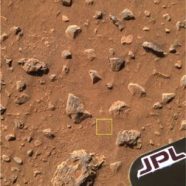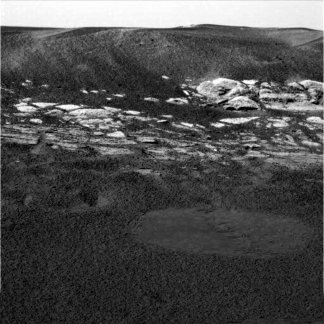Roving the Red Planet
Two little robots have touched down on Mars, ready to study the planet's rocks and soil.
This little robot is a long way from home. Spirit, a remote-controlled rover with six chunky wheels, made its first outing on Mars last week. But Spirit has gotten into trouble. It lost contact with scientists back on Earth for a while and suffered various computer glitches. Although mission scientists are making repairs, they’re not sure whether they can get Spirit back to full working order.
 |
|
The square marks the first patch of Martian soil examined by the rover Spirit.
|
| JPL/NASA |
Still, the rover did get some tasks done before malfunctioning. Spirit’s landing site is in a large crater known as Gusev. Scientists suspect that the crater may have once held a massive lake. Spirit’s job is to search for evidence of this lake in the crater’s rocks and soil.
The rover carries different types of tools for making these investigations, some of which are mounted on an extendable arm. Among the tools are two spectrometers—devices used to analyze the chemical makeup of an object or substance.
Spirit first used its spectrometers to study rocks and soil just 3 meters from its landing site. It found that the soil is rich in the elements chlorine, sulfur, silicon, and iron. The soil’s composition is similar to that of soil analyzed previously at three other Martian landing sites, says lead scientist Steve Squyres of Cornell University.
Spirit also found the first traces of nickel and zinc on Mars. And it detected a mineral called olivine—usually found in volcanic rock on Earth.
Scientists have long known that Mars is dotted with long-extinct volcanoes, such as the Olympus Mons, the largest volcano in the solar system. But the discovery of olivine also provides clues about the presence of water at the Gusev crater.
Harry Y. McSween of the University of Tennessee says that olivine quickly changes into different compounds when water is present. Because there’s still olivine at the Gusev crater, this could mean that there was never water at the site. Or it could be that the soil formed long after an ancient lake disappeared.
Squyres believes that lake sediments exist somewhere deep in the crater’s soil. He’s just not sure how far down they may be.
 |
|
This view from Opportunity shows interesting rock formations.
|
| JPL/NASA |
Mission scientists are working hard to fix Spirit. In the meantime, its sibling rover, Opportunity, is getting ready to wheel around on the opposite side of Mars—and taking some of the best pictures of Martian rock formations yet seen.—S. McDonagh
Going Deeper:
Cowen, Ron. 2004. Spirit gets its wheels dirty: Mars rover begins scientific work. Science News 165(Jan. 24):51-52. Available at http://www.sciencenews.org/20040124/fob2.asp .
For the latest images and news on the Mars rovers, go to marsrovers.jpl.nasa.gov/home/index.html.







